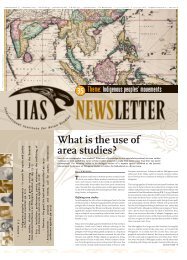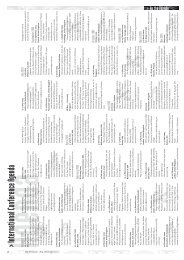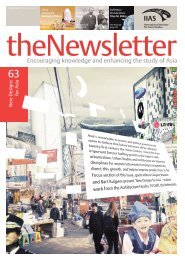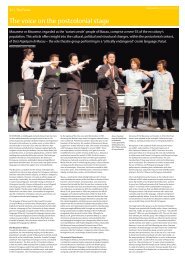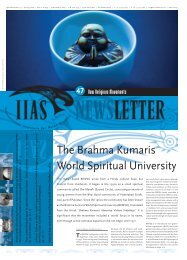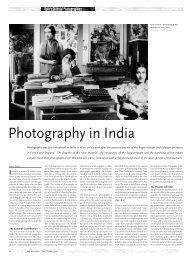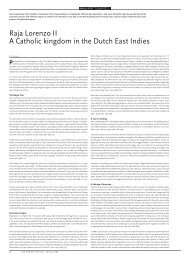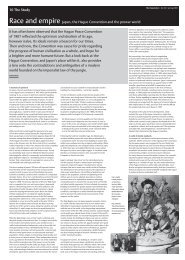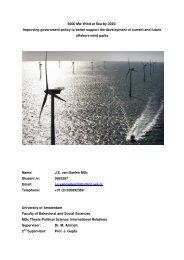Sex, love and revolution - IIAS
Sex, love and revolution - IIAS
Sex, love and revolution - IIAS
You also want an ePaper? Increase the reach of your titles
YUMPU automatically turns print PDFs into web optimized ePapers that Google loves.
T H E M E W o m e n W a r r i o r s<br />
Mention communists, guerillas, freedom fighters, militants <strong>and</strong> ideologues <strong>and</strong> the images that leap to mind<br />
are invariably male. In Asia, it is no different, except there is an added bias of patriarchy <strong>and</strong> of a history that<br />
has, until recently, been constructed <strong>and</strong> then recounted by former colonial powers <strong>and</strong> their historians. After<br />
independence, new ‘autonomous’ national histories had to be created <strong>and</strong> national curricula constructed,<br />
with those not fitting into these narratives either omitted or marginalised. Adrianna Tan examines the case of<br />
the women warriors of the Malayan Communist Party.<br />
The forgotten women warriors of<br />
the Malayan Communist Party<br />
Adrianna Tan<br />
Not surprisingly, a history - official,<br />
academic <strong>and</strong> popular - of the<br />
Malayan communists, with the Malayan<br />
Communist Party (MCP) at the core of the<br />
movement, is lacking. There is a penchant<br />
for dichotomous terms of good <strong>and</strong> evil,<br />
black <strong>and</strong> white. The conventional narrative<br />
is usually that of the ruthless Malayan<br />
Communists - typically Chinese <strong>and</strong> always<br />
male - versus the valiant <strong>and</strong> ultimately<br />
successful attempts of the colonial power<br />
<strong>and</strong> incoming national governments that<br />
saved the region from the global communist<br />
conspiracy.<br />
If there is anything certain at all about this<br />
particular part of history, it is that the version<br />
of those defeated has been as good<br />
as airbrushed out of history, or at least<br />
heavily tweaked. In fact, the communist<br />
movement in present day Singapore <strong>and</strong><br />
Malaysia, not to forget its hinterl<strong>and</strong>s in<br />
Thail<strong>and</strong>’s Muslim south, spanned the better<br />
part of the 20th century, first overlapping<br />
with the independence movements of<br />
these countries, then fighting against the<br />
post-independence governments, before<br />
petering out two decades ago when the<br />
guerillas finally laid down their arms in<br />
1989. Now in retirement <strong>and</strong> in their seventies<br />
or even eighties, several key figures<br />
of the MCP have narrated their version of<br />
events. 1<br />
Daughters, mothers,<br />
wives, <strong>love</strong>rs<br />
If it is true that the human side of the<br />
Malayan communist history is missing,<br />
this is even more so the case for the<br />
female angle. In fact, a surprising number<br />
of the MCP was female. While the exact<br />
number is not known, some put the figure<br />
as high as 30 per cent. What is known,<br />
however, is that their role was certainly<br />
significant. The women of the MCP were<br />
Chinese, Malay <strong>and</strong> Thai - born in China,<br />
Singapore, Malaysia <strong>and</strong> southern Thail<strong>and</strong>.<br />
They were comm<strong>and</strong>ers, leaders of<br />
civilian movements, members of the Politburo,<br />
rank <strong>and</strong> file soldiers; they were doctors,<br />
surgeons <strong>and</strong> nurses <strong>and</strong> they were<br />
in combat on the same terms as male soldiers.<br />
More importantly, they continued to<br />
be daughters, mothers, wives <strong>and</strong> <strong>love</strong>rs.<br />
They endured extreme hunger <strong>and</strong> physical<br />
<strong>and</strong> mental duress, then hunted elephants<br />
<strong>and</strong> wild boar alongside the men.<br />
They suffered terrible injuries in battle, ran,<br />
A young Li Qiu: an integral female member of the party, Li Qiu represented the MCP in China. She now lives in Beijing. Photograph courtesy of CC Chin.<br />
walked <strong>and</strong> carried the same heavy load as<br />
the men; <strong>and</strong> sometimes persevered when<br />
male comrades had given up.<br />
Some arrested male communists <strong>and</strong><br />
defectors were eager to point out to their<br />
interrogators how they preferred the treatment<br />
they received in captivity to that of<br />
their occasionally “terrifying… dem<strong>and</strong>ing”<br />
female comm<strong>and</strong>ers in the MCP. 2<br />
The women of MCP were known to be far<br />
tougher, physically <strong>and</strong> mentally, than their<br />
male counterparts, taking far more easily<br />
to the physical <strong>and</strong> mental dem<strong>and</strong>s of a<br />
life on the run. When captured, they rarely<br />
cracked under pressure or torture. It could<br />
be said they lived for the ideology they<br />
believed in, <strong>and</strong> took it to the grave.<br />
Yet little is known about these women <strong>and</strong><br />
the lives they led, except for one book of<br />
interviews <strong>and</strong> overlapping material from<br />
independent research about the MCP.<br />
Agnes Khoo’s groundbreaking “Life As<br />
the River Flows” (2004) is a collection of<br />
oral history interviews, giving a voice to the<br />
women of the MCP. But it is only a preliminary<br />
attempt at piecing together a coherent<br />
story about the women of the Malayan<br />
Communist Party. To my knowledge, no<br />
other narratives exist in either academic<br />
or popular history. Research <strong>and</strong> original<br />
material has been scarce <strong>and</strong> mostly in<br />
Chinese: the leading MCP researcher CC<br />
Chin <strong>and</strong> his counterparts have carried out<br />
meticulous research for decades, but seldom<br />
focused solely on the women. 3<br />
Khoo’s 16 interview partners freely discussed<br />
their lives, regrets, struggles,<br />
beliefs <strong>and</strong> hopes with the Singapore-born<br />
researcher. This preliminary narrative can<br />
hopefully open the door to a new interest<br />
in this important but often forgotten part<br />
of the contemporary history of the ‘Malay’<br />
peninsula. It is a story about women who<br />
were invisible when they were daughters<br />
<strong>and</strong> wives in the traditional Southeast Asia<br />
of the 1930s through to the 1960s <strong>and</strong><br />
1970s: Invisible when they left home to live<br />
out a life in the dense forests of Malaysia<br />
<strong>and</strong> Thail<strong>and</strong> <strong>and</strong> invisible again now as<br />
they find themselves on the wrong side of<br />
history - forgotten, banished, silenced by<br />
the state <strong>and</strong> by shame. In learning about<br />
their contribution to history, historians<br />
gain an underst<strong>and</strong>ing of some significant<br />
themes underlying this transnational<br />
struggle; while the rest of us may find some<br />
lessons from the story of female lives led<br />
bravely, harshly <strong>and</strong> sometimes brutally.<br />
1 2<br />
I I A S N E W S L E T T E R # 4 8 S u m m e r 2 0 0 8



